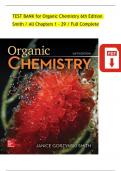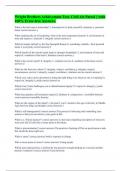TEST BANK for Organic Chemistry 6th Edition
Smith / All Chapters 1 - 29 / Full Complete
Page 1
,Chapter 1 Structure and Bonding
Chapter 2 Acids and Bases
Chapter 3 Introduction to Organic Molecules and Functional Groups
Chapter 4 Alkanes
Chapter 5 Stereochemistry
Chapter 6 Understanding Organic Reactions
Chapter 7 Alkyl Halides and Nucleophilic Substitution
Chapter 8 Alkyl Halides and Elimination Reactions
Chapter 9 Alcohols, Ethers, and Related Compounds
Chapter 10 Alkenes and Addition Reactions
Chapter 11 Alkynes and Synthesis
Chapter 12 Oxidation and Reduction
Spectroscopy A Mass Spectrometry
Spectroscopy B Infrared Spectroscopy
Spectroscopy C Nuclear Magnetic Resonance Spectroscopy
Chapter 13 Radical Reactions
Chapter 14 Conjugation, Resonance, and Dienes
Chapter 15 Benzene and Aromatic Compounds
Chapter 16 Reactions of Aromatic Compounds
Chapter 17 Introduction to Carbonyl Chemistry: Organometallic Reagents;
Oxidation and Reduction
Chapter 18 Aldehydes and Ketones—Nucleophilic Addition
Chapter 19 Carboxylic Acids and Nitriles
Chapter 20 Carboxylic Acids and Their Derivatives- Nucleophilic Acyl
Substitution
Chapter 21 Substitution Reactions of Carbonyl Compounds at the α-Carbon
Chapter 22 Carbonyl Condensation Reactions
Chapter 23 Amines
Chapter 24 Carbon-Carbon Bond-Forming Reactions in Organic Synthesis
Chapter 25 Pericyclic Reactions
Chapter 26 Carbohydrates
Chapter 27 Amino Acids and Proteins
Chapter 28 Synthetic Polymers
Chapter 29 Lipids (Available online)
Page 2
, Chapter 1: Structure and Bonding
1. What is the ground-state electronic configuration of a carbon atom?
A) 1s2, 2s2, 2p5 B) 1s2, 2s2, 2p2 C) 1s2, 2s2, 2p6 D) 1s2, 2s2, 2p4
2. What is the ground-state electronic configuration of a fluorine atom?
A) 1s2, 2s2, 2p2 B) 1s2, 2s2, 2p3 C) 1s2, 2s2, 2p4 D) 1s2, 2s2, 2p5
3. What is the ground-state electronic configuration of a magnesium cation (Mg2+)?
A) 1s2, 2s2, 2p6 C) 1s2, 2s2, 2p6, 3s2
B) 1s2, 2s2, 2p6, 3s1 D) 1s2, 2s2, 2p6, 3s2, 3p2
4. What is the ground-state electronic configuration of a chlorine anion (Cl—)?
A) 1s2, 2s2, 2p6 C) 1s2, 2s2, 2p6, 3s2, 3p5
B) 1s2, 2s2, 2p6, 3s2, 3p6 D) 1s2, 2s2, 2p6, 3s2, 3p4
5. Which of the following statements about valence electrons is true?
A) They are the most tightly held electrons.
B) They do not participate in chemical reactions.
Page 3
, Chapter 1: Structure and Bonding
C) They are the outermost electrons.
D) They reveal the period number of a second-row element.
6. Which of the following statements about bonding is true?
A) Covalent bonds result from the transfer of electrons from one element to another.
B) Ionic bonds result from the transfer of electrons from a metal to a non-metal.
C) Ionic bonds result from the sharing of electrons between two non-metals.
D) Covalent bonds result from the sharing of electrons between two metals.
7. Which of the following would you expect to have ionic bonds?
A) CO B) FBr C) NF3 D) NaCl
8. Which of the following molecules has nonpolar covalent bonds?
A) HCl B) N2 C) CHCl3 D) NO
9. Which of the following molecules contain both covalent and ionic bonds?
A) I, II B) I, IV C) II, III D) II, IV
10. Arrange the following bonds in decreasing order of ionic character, putting the most
ionic first.
A) I > II > III > IV C) IV > III > II > I
B) IV > II > I > III D) IV > II > III > I
11. Which of the following statements correctly describes the typical number of bonds for
carbon, nitrogen, and oxygen in most neutral organic molecules?
A) Carbon forms 4 covalent bonds, nitrogen forms 2 covalent bonds and oxygen forms
3 covalent bonds.
B) Carbon forms 4 covalent bonds, nitrogen forms 3 covalent bonds and oxygen forms
2 covalent bonds.
Page 4
, Chapter 1: Structure and Bonding
C) Carbon forms 4 covalent bonds, nitrogen forms 5 covalent bonds and oxygen forms
2 covalent bonds.
D) Carbon forms 4 covalent bonds, nitrogen forms 5 covalent bonds and oxygen forms
4 covalent bonds.
12. Which is not an acceptable Lewis structure for the anion CH2NCO—?
A) I B) II C) III D) IV
13. Which of the following Lewis structures is correct?
A) I B) II C) III D) IV
14. Which of the following Lewis structures is correct?
A) I, II B) I, III C) II, III D) III, IV
15. Which is the correct Lewis structure for acetic acid (CH3CO2H)?
A) I B) II C) III D) IV
Page 5
, Chapter 1: Structure and Bonding
16. In which of the following ions does carbon have a formal charge?
A) I B) II C) III D) None of the above
17. In which of the following ions does carbon have a formal charge?
A) I B) II C) III D) None of the above
18. What is the formal charge of carbon in carbon monoxide (CO) when drawn with a triple
bond?
A) 0 B) -2 C) -1 D) +1
19. Which of the following statements about constitutional isomers is true?
A) Constitutional isomers are different molecules having different molecular formula.
B) Constitutional isomers are different molecules having same molecular formula.
C) Constitutional isomers are same molecules having different molecular formula.
D) Constitutional isomers are same molecules having the same molecular formula.
20. How many constitutional isomers are there for a molecule having the molecular formula
C2H6O?
A) 1 B) 2 C) 3 D) 4
21. How many constitutional isomers are there for a molecule having the molecular C3H8O?
A) 1 B) 2 C) 3 D) 4
22. How many constitutional isomers are there for a molecule having the molecular formula
C3H6?
A) 1 B) 2 C) 3 D) 4
23. How many constitutional isomers are there for a molecule having the molecular formula
C2H4Cl2?
A) 1 B) 2 C) 3 D) 4
24. How many different isomers are there for a compound having the molecular formula
C3H6O?
A) 4 B) 5 C) 6 D) 7
Page 6
, Chapter 1: Structure and Bonding
25. Which of the following molecules are constitutional isomers?
A) I, II, IV B) II, III, IV C) I, III, IV D) I, II, III
26. Which of the following compounds has an atom with an unfilled valence shell of
electrons?
A) H2O B) BCl3 C) CH4 D) CO2
27. Which of the following statements about resonance structures is true?
A) Resonance structures have the same placement of electrons but different
arrangement of atoms.
B) Resonance structures have the same placement of atoms but different arrangement
of electrons.
C) Resonance structures have the same placement of atoms and the same arrangement
of electrons.
D) Resonance structures have different placement of atoms and different arrangement
of electrons.
28. Which of the following statements about resonance structures is not true?
A) There is no movement of electrons from one form to another.
B) Resonance structures are not isomers.
C) Resonance structures differ only in the arrangement of electrons.
D) Resonance structures are in equilibrium with each other.
29. Which of the following pair does not represent resonance structures?
A) I B) II C) III D) IV
Page 7
, Chapter 1: Structure and Bonding
30. What 2 things will change between two resonance structures?
A) The position of multiple bonds and non-bonded electrons.
B) The position of multiple bonds and single bonds.
C) The placement of atoms and single bonds.
D) The placement of atoms and non-bonded electrons.
31. Which of the following is a resonance structure of the compound below?
A) I B) II C) III D) IV
32. Which of the following resonance structures is the least important contributor to the
resonance hybrid of the formate anion, HCOO—?
A) I B) II C) III D) IV
33. Rank the following in order of decreasing importance as contributing structures to the
resonance hybrid of formaldehyde, H2CO.
A) I > II > III B) I > III > II C) II > I > III D) III > II > I
Page 8
, Chapter 1: Structure and Bonding
34. Follow the curved arrows to draw the second resonance structure for the ion below.
A) I B) II C) III D) IV
35. Which is more important in each pair of contributing resonance structures?
A) II, IV, V B) II, III, V C) II, III, VI D) I, IV, V
36. What is the approximate value of the H-C-H bond angle in methane, CH4 ?
A) 90° B) 109.5° C) 120° D) 180°
37. What is the approximate C-C-C bond angle in propene, CH3CH=CH2?
A) 90° B) 109.5° C) 120° D) 180°
38. What is the approximate H-C-O bond angle in formaldehyde, H2CO?
A) 90° B) 109.5° C) 120° D) 180°
Page 9





